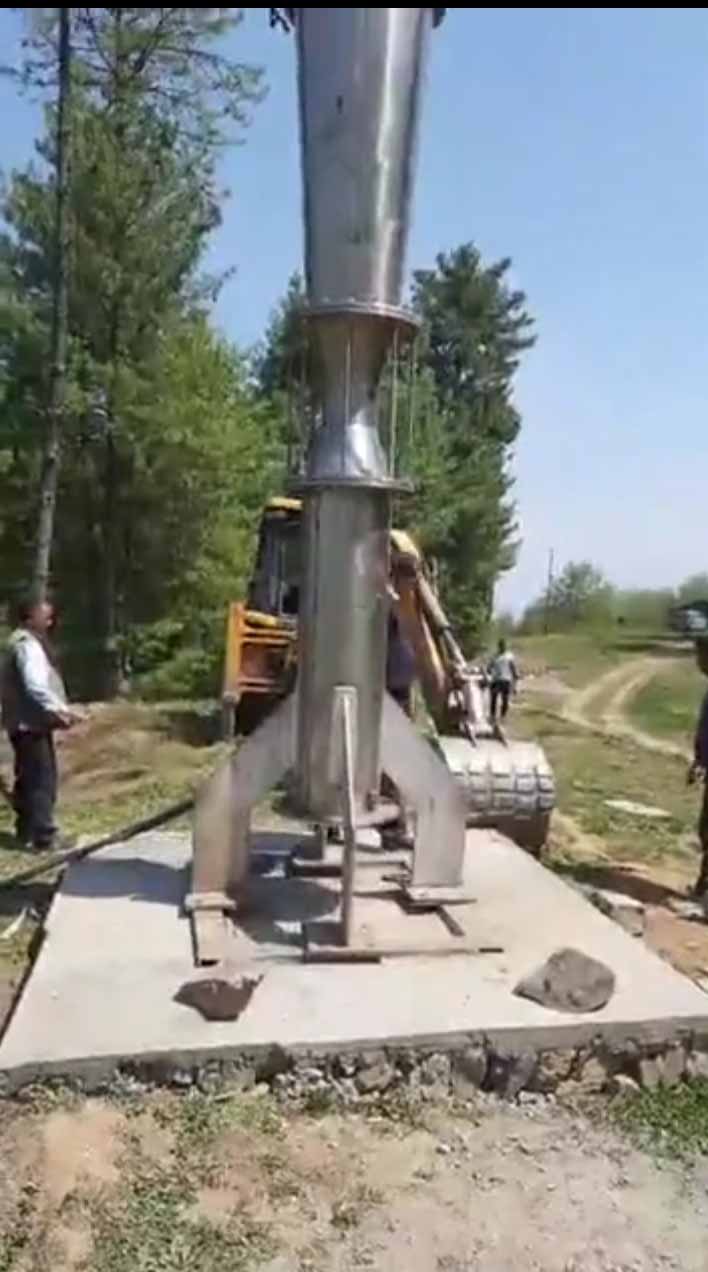MANDHOL/JUBBAL: Indian Institute of Technology, Bombay has installed its first Made in Bharat anti-hail gun system on the Badhol ridge near Mandhol village in Jubbal in the Shimla apple belt for a field trial in the hail-belt for the first time in India.
This anti-hail gun has rekindled hopes of farmers to save not only the apple crop, but also vegetable, flower and other crops from cataclysmic hail-stone storms in the hail-prone areas of Himachal Pradesh and Uttarakhand and Jammu and Kashmir- three major apple producers in India.
This anti-hail gun system is cost-effective, almost 80 per cent cheaper than the imported system, said Shubham Chauhan, an IIT Bombay engineer, who has come here to monitor its installation. “The cost of the anti-hail gun system is Rs 10 lakh. We will soon land it in the market once field trial is expected to be over this year”.
Shubham hails from Gujandli village, Rohru, who along with a team of engineers from IIT Bombay are here to monitor its operation for a field-trial.
What sets this anti-hail gun apart is that it is run by the LPG gas cylinder, a fuel abundantly available as of now and much cheaper than the acetylene gas, which is used in the imported system.
The commercial cylinder costs Rs 2300 or so where as a kg of acetylene could be as high as Rs 25000. Even its transportation is tricky. The cost of imported hail stone suppressing system in excess of Rs 90 lakh while the cost of operation is over Rs 25000 or so.
One LPG gas cylinder can run the anti-hail system for three to four hours. The gas along with the air, are lighted up in the gun that blasts up shockwaves and vibrations right into the hail clouds that go up to 16000 m where temperature of ice layer is - 50 Degree Centigrade or so, inform the scientists.
The speed of shockwaves is more than that of a supersonic jet that splits up cloud formation and prevents formation of hail stone (Sharoo) in upper layer of clouds and they fall down as rain or thin harmless flakes that cause no harms to apple fruit or other crops, the scientists say.
The anti-hail guns could be more effective as most of the valleys in Himachal are V-shaped. Here still people invoke local Devis and Devta to save crops from hail storms. They offer "Sharaag" an oblation of Prasad and prayer to Devta at the hilltop to prevent hail storms.
IIT Bombay will judge range of coverage of anti-hail gun during the field trial. But engineer expect it will be more than imported anti-hail gun system whose coverage is in a radius of 500 meter in the airspace, covering about 90 hectare area, which is also quite big enough.
As per estimates made by the farmers, the hail storms damage about 30 per cent of fruit crop, while marring the chances of crop in the next season, every year in the state. 
The farmers are using anti-hail nets to protect the crops from Hail stone. But the nets are labour-intensive and leave apple plants uncovered as the nets are not customised and size of tree varies from orchard to orchard. Even superstructure to support nets are expensive.
The hail-suppress system developed by IIT Bombay for the first time was tested at Kandaghat near Solan.
The scientists got good results. They installed this system here this week for a scientific field trial in the hail-prone belt of Mandhol-Sheelghat area.
IIT Bombay, Indian Space Research Organisation(ISRO), Defense Research Development Organisation(DRDO), Indian Meteorology Department(IMD) teamed up with Dr YS Parmar horticulture and forestry university, Nauni to develop Made- in-Bharat anti-hail gun system to save the apple and other crops from hail stone.
IIT Bombay has developed an automated anti-hail system and can be operated from Shimla by Internet.
All this is required to do is to link the gun with Kufri weather Doppler Radar that will guide the operator to fire the gun as soon as the Radar signals the formation of the clouds producing hail storms in the area, scientists said.
IIT Bombay engineers say that there is no data that suggest that anti-hail gun affect weather in other areas after gun is fired. The present feedback is that system is going on well and field trial will be successful, they say.
The hail season general starts from March to June, but there are extreme weather events when hail storms lash apple orchards in harvesting season from July to October as well, causing large scale damage to the standing crop.
The anti-hail gun technology was brought into focus in India by Himalayan apple man, late Lakshman Thakur, who hailed form Nandpur (Riuldhar), Jubbal valley and used to run Ecohort society.
Thakur along with Dr KD Verma, a former scientist from Nauni university had gone to Holland in October, 2004 to see anti-hail gun operation there. The anti-hail gun system was meticulously brought into the public forum by this author, who then worked in The Tribune since 2004 as early as 2008.
The then Horticulture Late Narender Bragta finally persuaded the state and central governments to install the anti-hail gun system in Shimla apple belt at three places – Badaunghat, Deorighat and Batar Galu in Jubbal-Kotkhai, his home constituency in 2011.
But lack of Doppler Radar system and field timing, trial and error, made the system not properly executed and attracted a lot of flak from the political parties and farmers and environmentalists.
Only Badaunghat gun system functioned properly as local farmers experienced “no hail storms for over seven years or so”. 
President of HP Fruit and Vegetable Growers Association Harish Chauhan said the farmers would get a major relief from the hailstorms as anti-hail gun system has been developed by the IIT Bombay involving all stakeholders including Dr YS Parmar university, DRDO, ISRO and IMD for a proper field trial. The guns are proving effective for suppressing the hail storms preventing huge losses caused to the farmers, he said.
He said the state government should install native anti-hail system in all hail prone apple valleys in Chopal, Jubbal-Kotkhai, Theog-Kotgarh, Rohru, Rampur, Mandi and Kullu districts to save crops from damage by hail stone.





